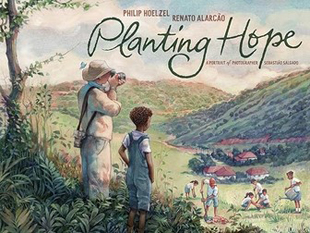Author Philip Hoelzel's inspiration for this book came from watching, The Salt of the Earth, a documentary about the life of photographer and humanitarian Sebastião Salgado, and then visiting Salgado's childhood home in Aimorés, Brazil. There Salgado and his wife Lélia created Instituto Terra, an environmental education center at which they and their allies replanted about seven hundred soccer fields' worth (!) of native trees.
The book gives readers a snapshot of Salgado's childhood on his parents' farm in the vast Mata Atlântica forest where, after finishing his chores, he could explore paradise: "He swam with the caimans and played under a waterfall. He trotted his horse through the forest while anteaters, tropical birds, and ocelots peered at him through the foliage."
Sebastião studied economics in São Paulo "to help people get the food, shelter, and money they needed to thrive." Political turmoil forced him and Lélia to move to Paris, where in a pivotal moment he purchased a camera to take photos for a class. Illustrator Renato Alarcão shows him experimenting with the camera and then a burst of light in the middle of his forehead as he realizes that he can use light to illuminate subjects.
Matching this newfound insight with his passion to help marginalized people, Salgado became an internationally acclaimed photojournalist, often photographing people in desperate circumstances. "Anything that hurts my heart or makes me happy, I want to see it and photograph it," he said. But when he covered the civil war in Rwanda, the death and violence made him ill. He put down his camera and returned to Brazil with Lélia.
When they arrived at his childhood farm, they found it in ruins. This sight could easily have driven them into further despair, but instead they decided to rebuild paradise.
Aimed at readers ages six to nine, this book will move the hearts of older readers, too. The illustrations — for instance, rain-forest plants twining through the silhouettes of Sebastião and Lélia as they embrace — capture the beauty and the hopefulness of their lives, even while many offer a child-sized glimpse of the suffering they witnessed.
The book concludes with an Author's Note, grateful acknowledgments, and information about both Instituto Terra and the vast Mata Atlântica, home to 52 percent of tree species and 92 percent of amphibians that are found nowhere else on Earth. This larger context underscores how invaluable Sebastião and Lélia's restoration work really is.
